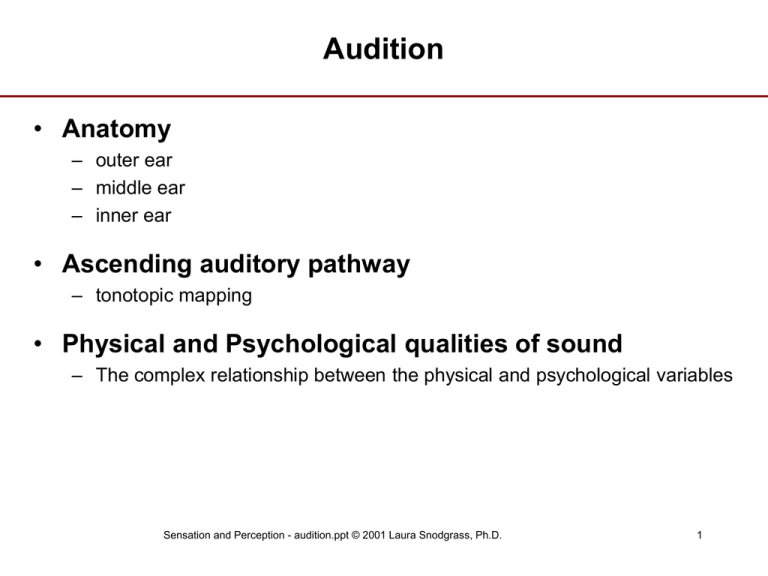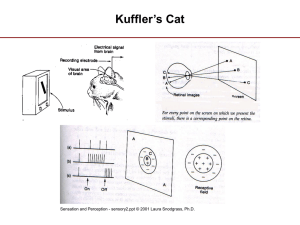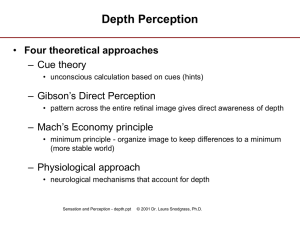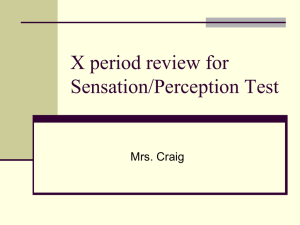Titles are 28pt. Arial Bold
advertisement

Audition • Anatomy – outer ear – middle ear – inner ear • Ascending auditory pathway – tonotopic mapping • Physical and Psychological qualities of sound – The complex relationship between the physical and psychological variables Sensation and Perception - audition.ppt © 2001 Laura Snodgrass, Ph.D. 1 Audition • The encoding of pitch • The encoding of loudness • The perception of complex tone combinations – Ohm’s law – exceptions Sensation and Perception - audition.ppt © 2001 Laura Snodgrass, Ph.D. 2 Anatomy * * Tympanic membrane Sensation and Perception - audition.ppt © 2001 Laura Snodgrass, Ph.D. 3 Anatomy • Outer ear – pinna (pinnae) - visible ear • funnels sound towards ear drum • helps in sound localization – external auditory canal – tympanic membrane • vibrates to transmit sound wave • Middle ear – ossicles - malleus, incus, stapes • amplifies vibrations – Eustachian tube • equalizes pressure Sensation and Perception - audition.ppt © 2001 Laura Snodgrass, Ph.D. 4 Anatomy Sensation and Perception - audition.ppt © 2001 Laura Snodgrass, Ph.D. 5 Anatomy • Inner ear - cochlea – oval window • sets up waves in the fluid filled cochlea – helicotrema • opening between the two outer tubes – transduction • basilar membrane • tectorial membrane • hair cells – round window releases pressure of waves – auditory nerve carries signal to brain Sensation and Perception - audition.ppt © 2001 Laura Snodgrass, Ph.D. 6 Anatomy Tectorial membrane Hair cells Sensation and Perception - audition.ppt © 2001 Laura Snodgrass, Ph.D. 7 Ascending Auditory Pathway Superior Olivary Nucleus reflexive localization Inferior Colliculus combines auditory with visual location information MGN selective attention Temporal Lobe left - language right - sounds tonotopic mapping Sensation and Perception - audition.ppt © 2001 Laura Snodgrass, Ph.D. 8 Tonotopic Mapping • Orderly representation of sound in the cortex – frequencies are represented parallel to the surface • lower frequencies are represented inferior (lower) than higher frequencies – loudness is represented as distance from the surface • soft sounds are represented near the surface • louder sounds are represented deeper in cortex Sensation and Perception - audition.ppt © 2001 Laura Snodgrass, Ph.D. 9 Tonotopic map of Temporal Lobe Sensation and Perception - audition.ppt © 2001 Laura Snodgrass, Ph.D. 10 Sound - Physical Qualities • Vibration in a medium • Alternating compressions and rarefactions of pressure • Physical variations in sound – frequency • number of cycles per second (cps) • often written as Hertz (Hz) – amplitude • degree of change in pressure • measured in decibels (Db) – complexity • number of different frequencies present Sensation and Perception - audition.ppt © 2001 Laura Snodgrass, Ph.D. 11 Amplitude Decibels 140 120 110 100 80 60 40 20 0 Sound Example Rock Band at close range Loud thunder Jet Plane from 500 feet Subway train from 20 feet Busy street corner Normal conversation Typical room noise Whisper Threshold for hearing Note: prolonged exposure to sounds over 85Db produces permanent hearing loss Sensation and Perception - audition.ppt © 2001 Laura Snodgrass, Ph.D. 12 Sound - Psychological Qualities • Pitch – varies from low to high – primarily based on frequency • Loudness – varies from soft to loud – primarily based on amplitude • Timbre – based on complexity – overtones Sensation and Perception - audition.ppt © 2001 Laura Snodgrass, Ph.D. 13 Complex Relationships • Unlike color perception, there is not a simple relationship between the physical and psychological variables in audition • Background – human range of hearing • 16 - 16,000 (16K) Hz (or 20 -20K) • octave = a doubling in frequency – e.g 20 Hz and 40 Hz are an octave apart, but 1,000 and 2,000 Hz are also an octave apart Sensation and Perception - audition.ppt © 2001 Laura Snodgrass, Ph.D. 14 Complex Relationships • Pitch is primarily based on frequency • Two other factors influence perceived pitch – instructions – amplitude • Instructions – when asked to indicate a change in tone subjects generate the jnd scale – when asked to indicate a change in musical note they generate the octave scale – therefore you need to know the instructions to know what the person will perceive Sensation and Perception - audition.ppt © 2001 Laura Snodgrass, Ph.D. 15 Pitch Scales 7 6 5 4 jnd 3 2 1 0 62 * 125 250 500 1000 2000 4000 8000 16000 Octave scale results in a straight line * least noticeable change is 0.25 Hz at about 15K, therefore for good recording equipment the wow and flutter must be less than .25Hz Sensation and Perception - audition.ppt © 2001 Laura Snodgrass, Ph.D. 16 Complex Relationships • Amplitude also influences pitch – as amplitude increases high tone get higher, low tones get lower, middle remain the same Sensation and Perception - audition.ppt © 2001 Laura Snodgrass, Ph.D. 17 Complex Relationships • Loudness is primarily based on amplitude – frequency also influences loudness • equal loudness contours • “loudness” control, graphic equalizer Sensation and Perception - audition.ppt © 2001 Laura Snodgrass, Ph.D. 18 Equal Loudness Contours Sensation and Perception - audition.ppt © 2001 Laura Snodgrass, Ph.D. 19 Encoding Pitch • Von Bekesy’s Place Theory – peak of the envelope of the traveling wave is at different locations along the basilar membrane for different pitches – high frequency near stapes – low frequency near helicotrema Sensation and Perception - audition.ppt © 2001 Laura Snodgrass, Ph.D. 20 Encoding Pitch Sensation and Perception - audition.ppt © 2001 Laura Snodgrass, Ph.D. 21 Encoding Pitch • Wever’s Volley Theory – nerves fire in a volley (sequence) to match frequency of pitch • Both types of encoding are used – above 5,000 Hz - place theory – 500 - 5,000 - both (very sensitive) – below 500 - volley Sensation and Perception - audition.ppt © 2001 Laura Snodgrass, Ph.D. 22 Encoding Loudness • Cells respond to a specific range of firing – within the range an increase in firing rate – e.g. a specific set of hair cells might respond to 10-30 Db • at 10 Db these cells fire slowly, at 20 Db they fire more rapidly, at 30Db they fire maximally, over 30 Db a new group of cells take over Sensation and Perception - audition.ppt © 2001 Laura Snodgrass, Ph.D. 23 Complex Tone Combinations • Ohm’s Law – the ear is a frequency analyzer (Fourier analysis) – given a complex waveform we hear the component frequencies • Exceptions to Ohm’s Law – Harmonics - we hear the multiples as timbre not separate tones • e.g. if 100 Hz is the fundamental, 200 Hz is the first harmonic and 300 Hz is the second harmonic • if 225 is the fundamental, the 450 is the first harmonic, and 675 is the second harmonic – Beats • small differences (1-6 Hz) are hear as a waxing and waning of amplitude Sensation and Perception - audition.ppt © 2001 Laura Snodgrass, Ph.D. 24







